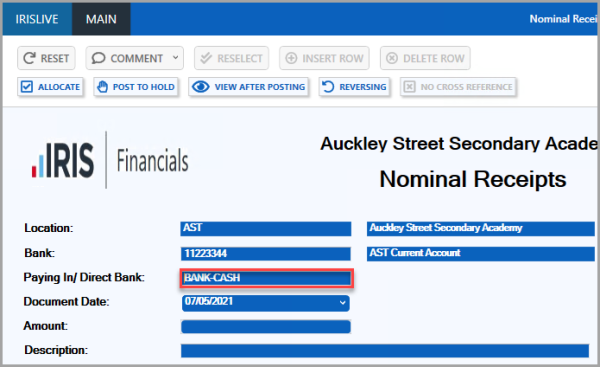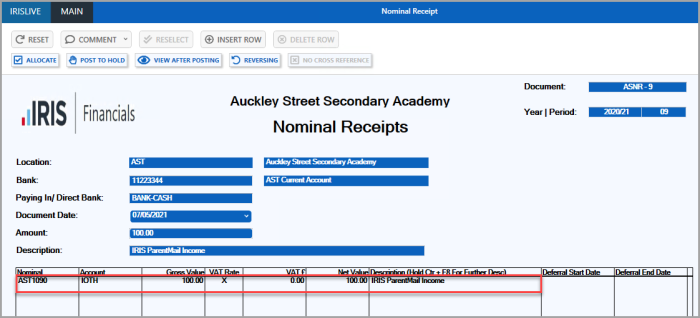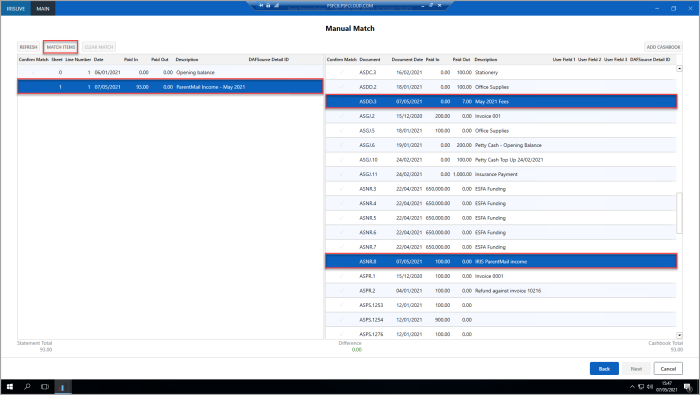Dealing with IRIS ParentMail or ParentPay transactions
Some Of the nominals and ledgers used in this topic may be different to those in your chart of accounts.
This topic explains the process of posting IRIS ParentMail or ParentPay transactions and how to reconcile these entries on your bank account within IRIS Financials.
There are three steps to post the required transactions:
- Posting a nominal receipt for the income
- Posting a non-order invoice for the fees
- Posting a direct debit to show payment of the fees that are deducted
This topic assumes you are familiar with selecting criteria for and completing document input forms. For more information, please see Completing document input forms.
Posting a nominal receipt
You need to post a nominal receipt to record the IRIS ParentMail or ParentPay income.
Do not post any expenditure/fees on the nominal receipt document, please use a non-order invoice. For more information, please see Posting a non-order invoice for the fees.
- Select Document, then select Document Input from the menu.
- The Document Input dialog is displayed. Select Drill (...) in Document type, then double-select to select ASNR - Nominal Receipt (where AS represents the location code of the document type) from the Select a document type dialog. The Nominal Receipt input form is automatically selected in Input form.
- The Date and Period default to today's date. You need to select the date the income was received from the calendar or enter the date in DD/Month/YYYY format, for example, 07 May 2021. To select the period in which the income was received, select Drill (...) in Period, then double-select to select the applicable period from the Select a period dialog.
- Select OK to confirm your selections.
- The Nominal Receipt document input form is displayed. Double-select in Bank, then double-select to select the bank account in which the income was received from the Select account dialog.
- Double-select in Paying In/Direct Bank, then double-select to select BANK-CASH from the Select PAYINORBANK key dialog.

- Enter the total income showing on your IRIS ParentMail or ParentPay statement in Amount, for example, 100.00 (do not enter any currency symbols, i.e., £, $, etc.)
- Enter a description to help identify the income in Description.
- Enter the income Nominal and Account for the income, then select a VAT Rate of X.
- Enter a description for the item in Description, then press F5 or select POST to post the document.

Posting a non-order invoice for the fees
A non-order purchase invoice must be posted to the applicable IRIS ParentMail or ParentPay supplier account to show the fees on your statement.
- Go to Documents, then select Document Input from the menu.
-
The Document Input dialog is displayed. Select Drill (...) in Document type, then double-select to select ASPI - Non Purchase Order Invoices (where AS represents the location code of the document type) from the Select a document type dialog. The Purchase Invoice input form is automatically selected in Input form.
If the Non Order Purchase Invoice needs to be authorised, select ... in Input form, then select Purchase Invoice To Authorise from the Select an input form dialog.
- The Date and Period default to today's date. You need to select the date the income was received from the calendar or enter the date in DD/Month/YYYY format, for example, 07 May 2021. To select the period in which the income was received, select ... in Period, then double-select to select the applicable period from the Select a period dialog.
- Select OK to confirm your selections.
- The Purchase Invoice document input form is displayed. Double-select in Account, then double-select to select the applicable ParentMail or ParentPay supplier account from the Select account dialog.
- Enter the Statement number or period the income relates to in Invoice Number.
- Enter the full amount of the fees, including any VAT in Document Control, for example, 7.00 (do not enter any currency symbols, such as £, $, €).
- If your non-order invoices need to be authorised, double-select in Authoriser, then double-select to select the required authoriser from the Select AUTHORISER key dialog.
- Enter the expenditure Nominal and Account for the fees, then select the applicable VAT Rate.
- Enter a description in Description, then press F5 or select POST to post the document.

Posting a direct debit using the Purchase Payment input form
The direct debit document is used to show the payment for the fees you posted in the previous section and is used to reconcile your bank account with your bank statement. It is also allocated with the non-order invoice to stop it from appearing on a payment run.
- Go to Documents, then select Document Input from the menu.
- The Document Input dialog is displayed. Select ... in Document type, then double-select to select ASDD - Direct Debit or Standing Order (where AS represents the location code of the document type) from the Select a document type dialog. The Purchase Payment input form is automatically selected in Input form.
- The Date and Period default to today's date. You need to select the date the income was received from the calendar or enter the date in DD/Month/YYYY format, for example, 07 May 2021. To select the period in which the income was received, select ... in Period, then double-select to select the applicable period from the Select a period dialog.
- Select OK to confirm your selections.
- The Purchase Payment document input form is displayed. Double-select in Bank, then double-select to select the bank account in which the income was received from the Select account dialog.
- Double-select in Account, then double-select to select the applicable ParentMail or ParentPay supplier account from the Select account dialog.
- Enter the total amount of the fees in Value, e.g. 7.00 (do not enter any currency symbols, such as £, $, €), then enter a description in Description.
- Press Shift+F5 or select ALLOCATE and then POST to post the document so you can allocate to the Non-Order Invoice you posted in the previous section.
- The Allocation dialog is displayed. Drag the non-order invoice document relating to the fees onto the direct debit document. For more information, please see Allocating and unallocating documents.
- Both documents are displayed together on the left-hand side of the Allocation dialog. select SAVE to confirm the allocation.
Reconciling the transaction on the bank account
This section assumes you are familiar with reconciling bank transactions. For more information, please see Reconciling bank transactions.
- Go to Banks, then select Bank Reconciliation from the menu.
- The Bank Reconciliation wizard is displayed. Select ... in Bank Account, then select the bank account in which the income was received from the Select a bank account dialog. and select the applicable bank account.
- Select Match one to one, then select Next.
- The Manual Match dialog is displayed. Hold Ctrl, then select the direct debit and non-order invoice documents you posted earlier on from the right-hand panel so they are highlighted. Then select the applicable entry on the bank statement from the left-hand panel.

- Select MATCH ITEMS to reconcile the entries together.